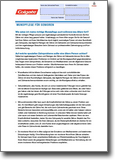Periodontitis
Treatment of sensitive teeth in periodontitis |
Depth measurement of gingival pockets |
Treatment of deep pockets |
Bone loss in periodontitis |
Periodontitis (sometimes erroneously called periodontitis) is an inflammation of the tooth bed (periodontium). Like gingivitis, periodontitis is triggered by bacterial plaque. However, the main difference is the bone loss that occurs in periodontitis, which can lead to tooth loss.
In industrialized countries, periodontitis is the most common chronic infectious disease and thus also the most important risk factor for diseases outside the oral cavity. Thus, there is a connection between periodontitis and hardening of the arteries, heart disease, vascular disease as well as stroke and heart attack. The risk of developing periodontitis is increased by smoking, inadequate dental care, improper nutrition and metabolic diseases. Anyone who grinds their teeth at night or breathes with their mouth open also belongs to the risk group.
What many do not know: Periodontitis is quite transmissible. So if the life partner suffers from this disease, the risk of infection is great. Infection from mother to child is also possible.
Commonly, teeth can develop periodontitis unnoticed even with good care. From a simple gingivitis of gingivitis, periodontitis can develop without you noticing clear signs of it. The disease progresses insidiously and usually without pain. In addition to occasional bleeding gums, bad breath, change in tooth position or lengthening and loosened tooth necks may occur.
How does periodontitis develop?
Normally, the gums adhere tightly to the tooth. The periodontium includes the gums (gingiva), the root skin (desmodont) and the jawbone. The root of the tooth is fixed in the jaw with the help of the root skin. The root membrane consists of many thousands of fibers, which firmly connect the tooth with the surrounding jawbone. Due to the close connection, no germs can penetrate. If the plaque is not removed by lack of hygiene, tartar can now form through minerals from the saliva. On its rough surface, in turn, unwanted bacteria can spread. Over time, a so-called biofilm is formed.
In such a biofilm, bacteria are connected in a kind of three-dimensional network. As if mixed with adhesive, they adhere firmly to each other and to the tooth surface. The removal of this viscous mass by simple rinsing is no longer possible. Due to the biofilm, the bacteria are only accessible to the body's own defense and also to drugs such as antibiotics to a limited extent. Protected in this way, they can produce their toxic waste products (toxins), which then drive inflammation of the gums.
The biofilm is thus able to spread further and pushes itself further between the root of the tooth and the gums. The result is the so-called gingival pocket which exposes the tooth more and more.
Due to misinformation in the disturbed cell communication, in addition to the loosening process between the tooth and the tooth bed, the jawbone also breaks down. The end result can be the complete detachment of the tooth from the holding apparatus and thus its loss.
Warning signs of periodontitis can be:
- Bleeding gums
- Reduction of gums
- Touch-sensitive gums
- Pus discharge when pressed on gums
- Reddened, swollen gums
- Bad breath, bad breath
- Loose or migrating teeth
- Changes in biting behaviour (bite)
- Altered prosthesis fit, poor hold of the prosthesis
Course of treatment
In any case, it is very important to treat periodontitis in time. Otherwise, there is a risk of premature tooth loss. First, plaque and tartar are removed. Because only when the tooth surface is smooth, the gums can put on again and the gingival pocket close again permanently. It is also possible to determine the bacteria present there by taking a swab from the gingival pocket. It may be useful to use an antibiotic for support.Then the bacteria are removed from the gingival pockets With a very fine scraper, the curette, the dentist grates the fossilized plaque from the root surfaces in the gingival pockets. If the jawbone has already shrunk considerably, it can be rebuilt if necessary. (see bone augmentation)
If you have been diagnosed with periodontitis, you should have the depth of your gingival pockets checked regularly. The dentist compares the result with the previous examinations. A one-time check-up and treatment is not enough, otherwise you risk that periodontitis will continue to progress unnoticed.
Word meanings:
Periodontitis - inflammation of the gums or PeriodontiumPeriodontium - or periodontum - the periodontium
Periodontitis - loss of the gums or periodontium without inflammation
further information about periodontitis
 |
 |
 |
 |
 |
||||
 |
 |
 |
 |
 |
||||
 |
 |
|||||||














